Comparative Analysis of LD and Althusser Approaches to Media
VerifiedAdded on 2020/04/07
|9
|2617
|81
AI Summary
The assignment delves into contrasting theories on the relationship between media and individuals, specifically comparing the Liberal Democratic (LD) approach and the Althusser approach. The LD approach posits that individuals are rational and autonomous entities capable of making selective choices about media consumption, emphasizing a balanced interaction between society, media, and personal choice. Conversely, the Althusser perspective argues that individuals are subjects who have been interpellated into specific roles by dominant ideologies, primarily through institutions like media, which act as Ideological State Apparatuses (ISAs). These ISAs, including media, shape perceptions of reality, reinforcing societal structures by defining 'good' and 'bad' social groups. Both perspectives offer insightful views on the power dynamics at play in society, highlighting how media can either empower individual autonomy or reinforce ideological control.
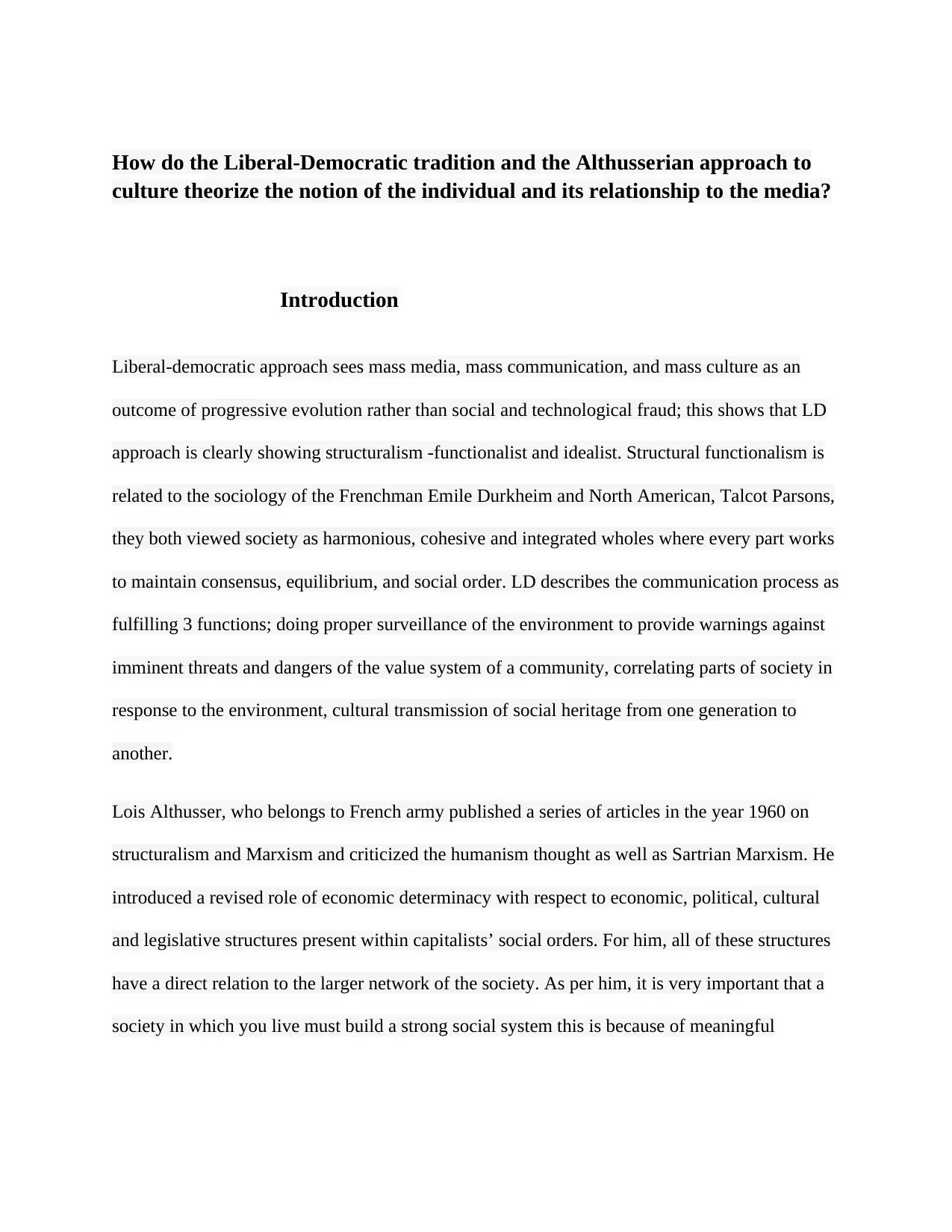
How do the Liberal-Democratic tradition and the Althusserian approach to
culture theorize the notion of the individual and its relationship to the media?
Introduction
Liberal-democratic approach sees mass media, mass communication, and mass culture as an
outcome of progressive evolution rather than social and technological fraud; this shows that LD
approach is clearly showing structuralism -functionalist and idealist. Structural functionalism is
related to the sociology of the Frenchman Emile Durkheim and North American, Talcot Parsons,
they both viewed society as harmonious, cohesive and integrated wholes where every part works
to maintain consensus, equilibrium, and social order. LD describes the communication process as
fulfilling 3 functions; doing proper surveillance of the environment to provide warnings against
imminent threats and dangers of the value system of a community, correlating parts of society in
response to the environment, cultural transmission of social heritage from one generation to
another.
Lois Althusser, who belongs to French army published a series of articles in the year 1960 on
structuralism and Marxism and criticized the humanism thought as well as Sartrian Marxism. He
introduced a revised role of economic determinacy with respect to economic, political, cultural
and legislative structures present within capitalists’ social orders. For him, all of these structures
have a direct relation to the larger network of the society. As per him, it is very important that a
society in which you live must build a strong social system this is because of meaningful
culture theorize the notion of the individual and its relationship to the media?
Introduction
Liberal-democratic approach sees mass media, mass communication, and mass culture as an
outcome of progressive evolution rather than social and technological fraud; this shows that LD
approach is clearly showing structuralism -functionalist and idealist. Structural functionalism is
related to the sociology of the Frenchman Emile Durkheim and North American, Talcot Parsons,
they both viewed society as harmonious, cohesive and integrated wholes where every part works
to maintain consensus, equilibrium, and social order. LD describes the communication process as
fulfilling 3 functions; doing proper surveillance of the environment to provide warnings against
imminent threats and dangers of the value system of a community, correlating parts of society in
response to the environment, cultural transmission of social heritage from one generation to
another.
Lois Althusser, who belongs to French army published a series of articles in the year 1960 on
structuralism and Marxism and criticized the humanism thought as well as Sartrian Marxism. He
introduced a revised role of economic determinacy with respect to economic, political, cultural
and legislative structures present within capitalists’ social orders. For him, all of these structures
have a direct relation to the larger network of the society. As per him, it is very important that a
society in which you live must build a strong social system this is because of meaningful
Paraphrase This Document
Need a fresh take? Get an instant paraphrase of this document with our AI Paraphraser
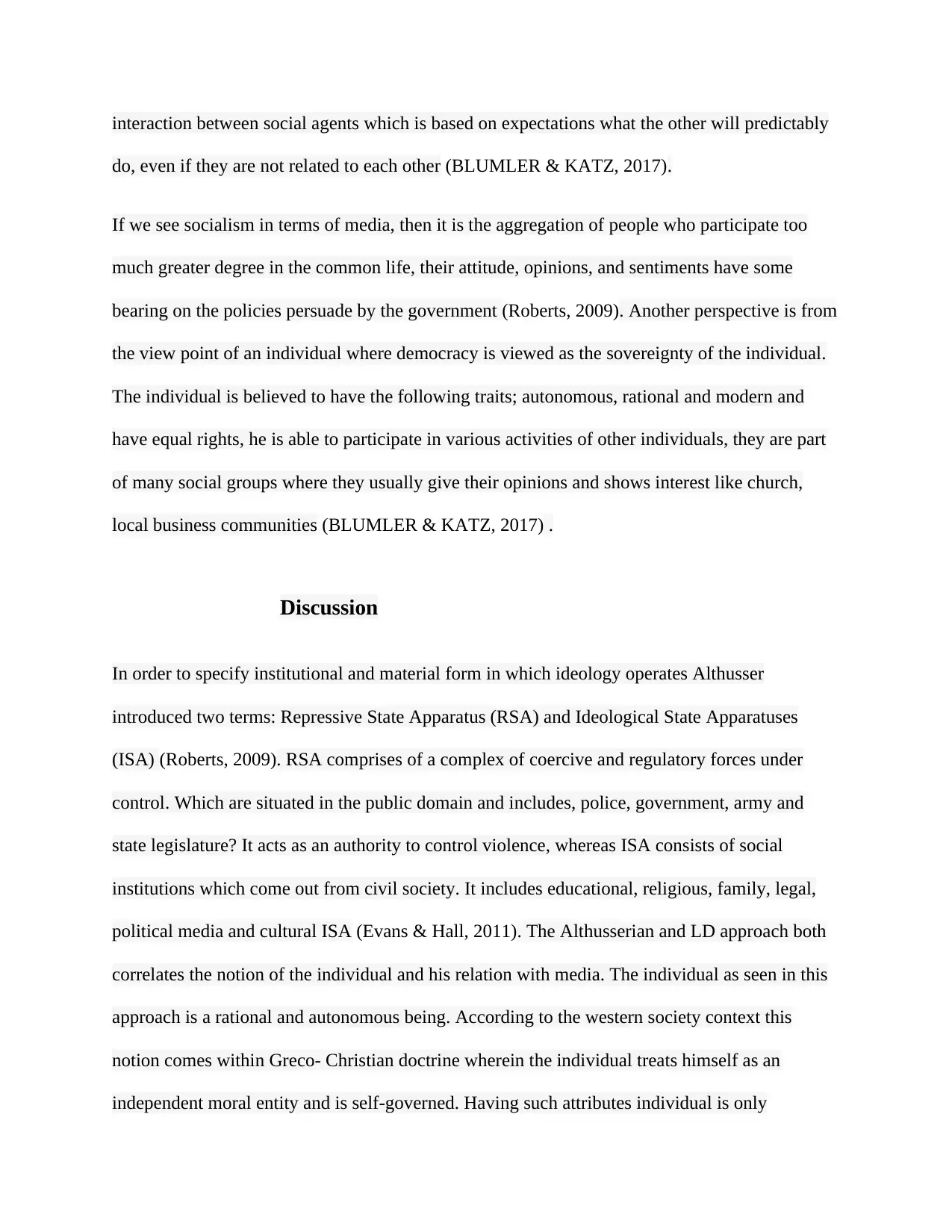
interaction between social agents which is based on expectations what the other will predictably
do, even if they are not related to each other (BLUMLER & KATZ, 2017).
If we see socialism in terms of media, then it is the aggregation of people who participate too
much greater degree in the common life, their attitude, opinions, and sentiments have some
bearing on the policies persuade by the government (Roberts, 2009). Another perspective is from
the view point of an individual where democracy is viewed as the sovereignty of the individual.
The individual is believed to have the following traits; autonomous, rational and modern and
have equal rights, he is able to participate in various activities of other individuals, they are part
of many social groups where they usually give their opinions and shows interest like church,
local business communities (BLUMLER & KATZ, 2017) .
Discussion
In order to specify institutional and material form in which ideology operates Althusser
introduced two terms: Repressive State Apparatus (RSA) and Ideological State Apparatuses
(ISA) (Roberts, 2009). RSA comprises of a complex of coercive and regulatory forces under
control. Which are situated in the public domain and includes, police, government, army and
state legislature? It acts as an authority to control violence, whereas ISA consists of social
institutions which come out from civil society. It includes educational, religious, family, legal,
political media and cultural ISA (Evans & Hall, 2011). The Althusserian and LD approach both
correlates the notion of the individual and his relation with media. The individual as seen in this
approach is a rational and autonomous being. According to the western society context this
notion comes within Greco- Christian doctrine wherein the individual treats himself as an
independent moral entity and is self-governed. Having such attributes individual is only
do, even if they are not related to each other (BLUMLER & KATZ, 2017).
If we see socialism in terms of media, then it is the aggregation of people who participate too
much greater degree in the common life, their attitude, opinions, and sentiments have some
bearing on the policies persuade by the government (Roberts, 2009). Another perspective is from
the view point of an individual where democracy is viewed as the sovereignty of the individual.
The individual is believed to have the following traits; autonomous, rational and modern and
have equal rights, he is able to participate in various activities of other individuals, they are part
of many social groups where they usually give their opinions and shows interest like church,
local business communities (BLUMLER & KATZ, 2017) .
Discussion
In order to specify institutional and material form in which ideology operates Althusser
introduced two terms: Repressive State Apparatus (RSA) and Ideological State Apparatuses
(ISA) (Roberts, 2009). RSA comprises of a complex of coercive and regulatory forces under
control. Which are situated in the public domain and includes, police, government, army and
state legislature? It acts as an authority to control violence, whereas ISA consists of social
institutions which come out from civil society. It includes educational, religious, family, legal,
political media and cultural ISA (Evans & Hall, 2011). The Althusserian and LD approach both
correlates the notion of the individual and his relation with media. The individual as seen in this
approach is a rational and autonomous being. According to the western society context this
notion comes within Greco- Christian doctrine wherein the individual treats himself as an
independent moral entity and is self-governed. Having such attributes individual is only
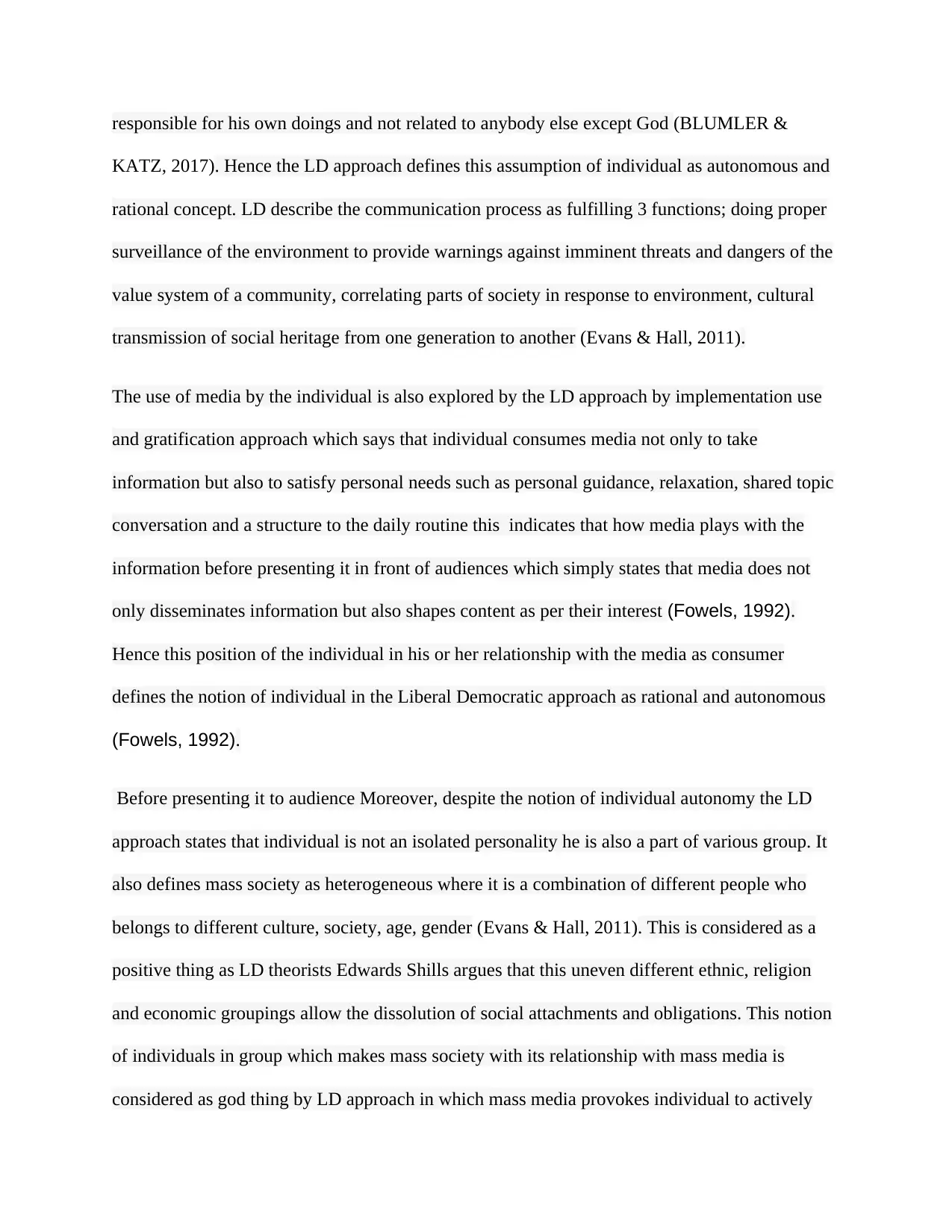
responsible for his own doings and not related to anybody else except God (BLUMLER &
KATZ, 2017). Hence the LD approach defines this assumption of individual as autonomous and
rational concept. LD describe the communication process as fulfilling 3 functions; doing proper
surveillance of the environment to provide warnings against imminent threats and dangers of the
value system of a community, correlating parts of society in response to environment, cultural
transmission of social heritage from one generation to another (Evans & Hall, 2011).
The use of media by the individual is also explored by the LD approach by implementation use
and gratification approach which says that individual consumes media not only to take
information but also to satisfy personal needs such as personal guidance, relaxation, shared topic
conversation and a structure to the daily routine this indicates that how media plays with the
information before presenting it in front of audiences which simply states that media does not
only disseminates information but also shapes content as per their interest (Fowels, 1992).
Hence this position of the individual in his or her relationship with the media as consumer
defines the notion of individual in the Liberal Democratic approach as rational and autonomous
(Fowels, 1992).
Before presenting it to audience Moreover, despite the notion of individual autonomy the LD
approach states that individual is not an isolated personality he is also a part of various group. It
also defines mass society as heterogeneous where it is a combination of different people who
belongs to different culture, society, age, gender (Evans & Hall, 2011). This is considered as a
positive thing as LD theorists Edwards Shills argues that this uneven different ethnic, religion
and economic groupings allow the dissolution of social attachments and obligations. This notion
of individuals in group which makes mass society with its relationship with mass media is
considered as god thing by LD approach in which mass media provokes individual to actively
KATZ, 2017). Hence the LD approach defines this assumption of individual as autonomous and
rational concept. LD describe the communication process as fulfilling 3 functions; doing proper
surveillance of the environment to provide warnings against imminent threats and dangers of the
value system of a community, correlating parts of society in response to environment, cultural
transmission of social heritage from one generation to another (Evans & Hall, 2011).
The use of media by the individual is also explored by the LD approach by implementation use
and gratification approach which says that individual consumes media not only to take
information but also to satisfy personal needs such as personal guidance, relaxation, shared topic
conversation and a structure to the daily routine this indicates that how media plays with the
information before presenting it in front of audiences which simply states that media does not
only disseminates information but also shapes content as per their interest (Fowels, 1992).
Hence this position of the individual in his or her relationship with the media as consumer
defines the notion of individual in the Liberal Democratic approach as rational and autonomous
(Fowels, 1992).
Before presenting it to audience Moreover, despite the notion of individual autonomy the LD
approach states that individual is not an isolated personality he is also a part of various group. It
also defines mass society as heterogeneous where it is a combination of different people who
belongs to different culture, society, age, gender (Evans & Hall, 2011). This is considered as a
positive thing as LD theorists Edwards Shills argues that this uneven different ethnic, religion
and economic groupings allow the dissolution of social attachments and obligations. This notion
of individuals in group which makes mass society with its relationship with mass media is
considered as god thing by LD approach in which mass media provokes individual to actively
⊘ This is a preview!⊘
Do you want full access?
Subscribe today to unlock all pages.

Trusted by 1+ million students worldwide
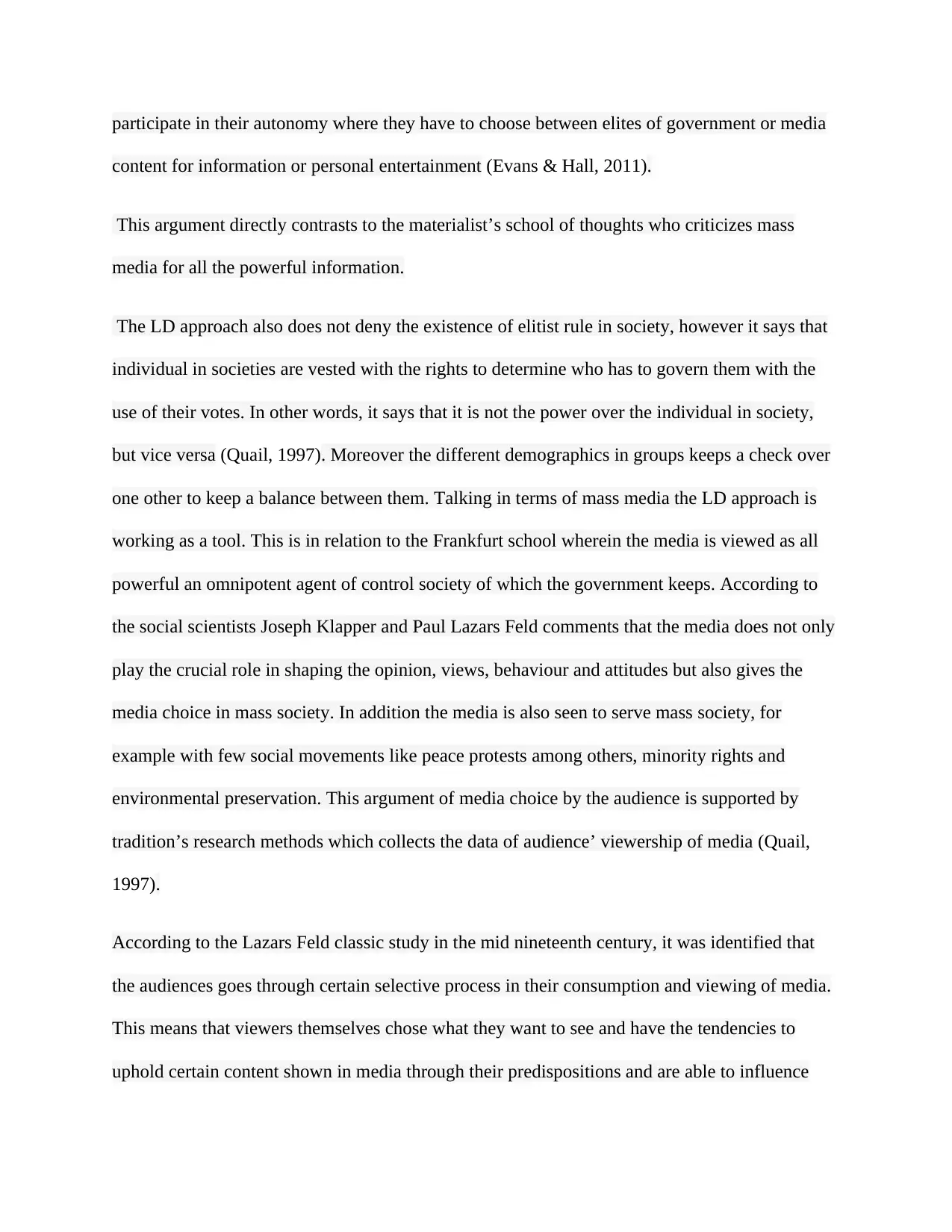
participate in their autonomy where they have to choose between elites of government or media
content for information or personal entertainment (Evans & Hall, 2011).
This argument directly contrasts to the materialist’s school of thoughts who criticizes mass
media for all the powerful information.
The LD approach also does not deny the existence of elitist rule in society, however it says that
individual in societies are vested with the rights to determine who has to govern them with the
use of their votes. In other words, it says that it is not the power over the individual in society,
but vice versa (Quail, 1997). Moreover the different demographics in groups keeps a check over
one other to keep a balance between them. Talking in terms of mass media the LD approach is
working as a tool. This is in relation to the Frankfurt school wherein the media is viewed as all
powerful an omnipotent agent of control society of which the government keeps. According to
the social scientists Joseph Klapper and Paul Lazars Feld comments that the media does not only
play the crucial role in shaping the opinion, views, behaviour and attitudes but also gives the
media choice in mass society. In addition the media is also seen to serve mass society, for
example with few social movements like peace protests among others, minority rights and
environmental preservation. This argument of media choice by the audience is supported by
tradition’s research methods which collects the data of audience’ viewership of media (Quail,
1997).
According to the Lazars Feld classic study in the mid nineteenth century, it was identified that
the audiences goes through certain selective process in their consumption and viewing of media.
This means that viewers themselves chose what they want to see and have the tendencies to
uphold certain content shown in media through their predispositions and are able to influence
content for information or personal entertainment (Evans & Hall, 2011).
This argument directly contrasts to the materialist’s school of thoughts who criticizes mass
media for all the powerful information.
The LD approach also does not deny the existence of elitist rule in society, however it says that
individual in societies are vested with the rights to determine who has to govern them with the
use of their votes. In other words, it says that it is not the power over the individual in society,
but vice versa (Quail, 1997). Moreover the different demographics in groups keeps a check over
one other to keep a balance between them. Talking in terms of mass media the LD approach is
working as a tool. This is in relation to the Frankfurt school wherein the media is viewed as all
powerful an omnipotent agent of control society of which the government keeps. According to
the social scientists Joseph Klapper and Paul Lazars Feld comments that the media does not only
play the crucial role in shaping the opinion, views, behaviour and attitudes but also gives the
media choice in mass society. In addition the media is also seen to serve mass society, for
example with few social movements like peace protests among others, minority rights and
environmental preservation. This argument of media choice by the audience is supported by
tradition’s research methods which collects the data of audience’ viewership of media (Quail,
1997).
According to the Lazars Feld classic study in the mid nineteenth century, it was identified that
the audiences goes through certain selective process in their consumption and viewing of media.
This means that viewers themselves chose what they want to see and have the tendencies to
uphold certain content shown in media through their predispositions and are able to influence
Paraphrase This Document
Need a fresh take? Get an instant paraphrase of this document with our AI Paraphraser
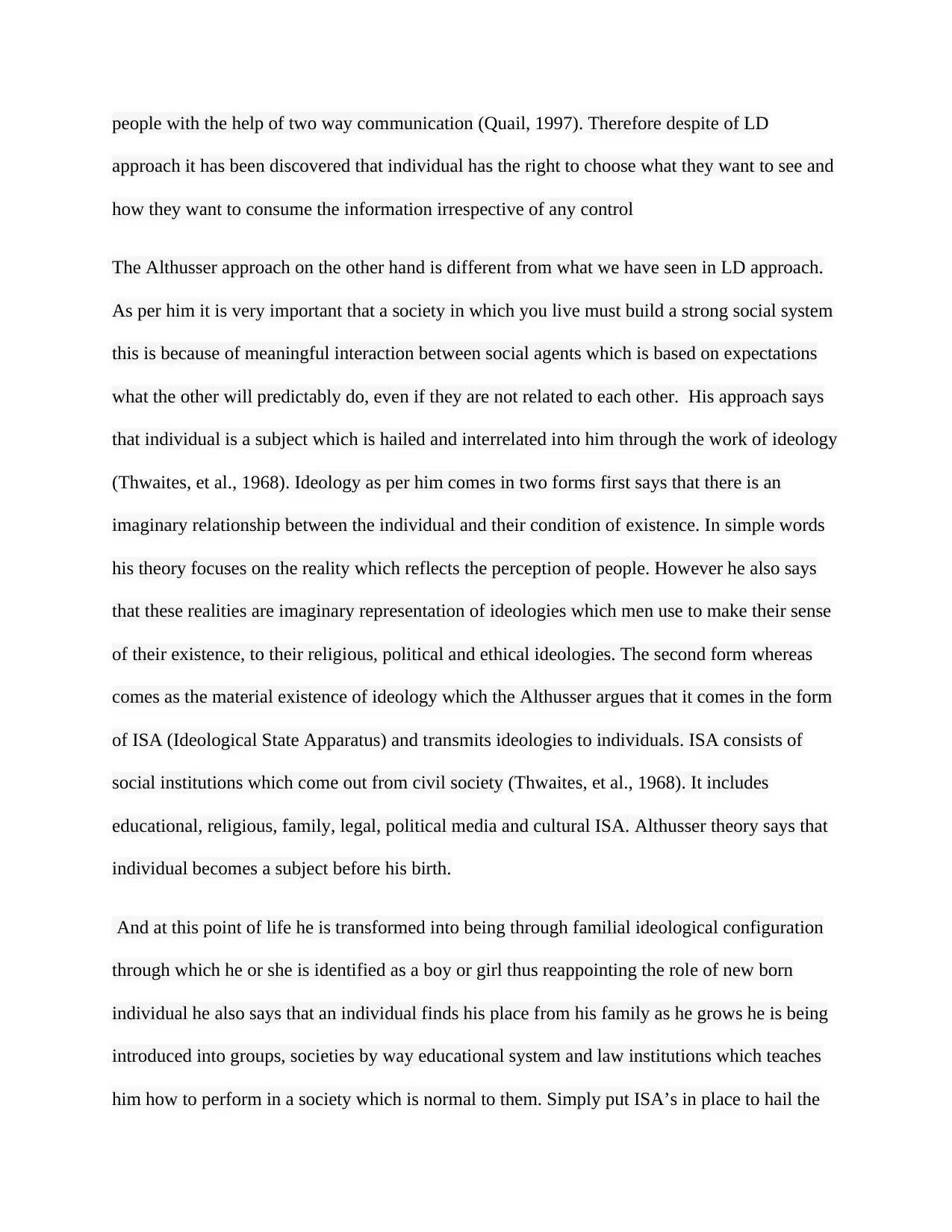
people with the help of two way communication (Quail, 1997). Therefore despite of LD
approach it has been discovered that individual has the right to choose what they want to see and
how they want to consume the information irrespective of any control
The Althusser approach on the other hand is different from what we have seen in LD approach.
As per him it is very important that a society in which you live must build a strong social system
this is because of meaningful interaction between social agents which is based on expectations
what the other will predictably do, even if they are not related to each other. His approach says
that individual is a subject which is hailed and interrelated into him through the work of ideology
(Thwaites, et al., 1968). Ideology as per him comes in two forms first says that there is an
imaginary relationship between the individual and their condition of existence. In simple words
his theory focuses on the reality which reflects the perception of people. However he also says
that these realities are imaginary representation of ideologies which men use to make their sense
of their existence, to their religious, political and ethical ideologies. The second form whereas
comes as the material existence of ideology which the Althusser argues that it comes in the form
of ISA (Ideological State Apparatus) and transmits ideologies to individuals. ISA consists of
social institutions which come out from civil society (Thwaites, et al., 1968). It includes
educational, religious, family, legal, political media and cultural ISA. Althusser theory says that
individual becomes a subject before his birth.
And at this point of life he is transformed into being through familial ideological configuration
through which he or she is identified as a boy or girl thus reappointing the role of new born
individual he also says that an individual finds his place from his family as he grows he is being
introduced into groups, societies by way educational system and law institutions which teaches
him how to perform in a society which is normal to them. Simply put ISA’s in place to hail the
approach it has been discovered that individual has the right to choose what they want to see and
how they want to consume the information irrespective of any control
The Althusser approach on the other hand is different from what we have seen in LD approach.
As per him it is very important that a society in which you live must build a strong social system
this is because of meaningful interaction between social agents which is based on expectations
what the other will predictably do, even if they are not related to each other. His approach says
that individual is a subject which is hailed and interrelated into him through the work of ideology
(Thwaites, et al., 1968). Ideology as per him comes in two forms first says that there is an
imaginary relationship between the individual and their condition of existence. In simple words
his theory focuses on the reality which reflects the perception of people. However he also says
that these realities are imaginary representation of ideologies which men use to make their sense
of their existence, to their religious, political and ethical ideologies. The second form whereas
comes as the material existence of ideology which the Althusser argues that it comes in the form
of ISA (Ideological State Apparatus) and transmits ideologies to individuals. ISA consists of
social institutions which come out from civil society (Thwaites, et al., 1968). It includes
educational, religious, family, legal, political media and cultural ISA. Althusser theory says that
individual becomes a subject before his birth.
And at this point of life he is transformed into being through familial ideological configuration
through which he or she is identified as a boy or girl thus reappointing the role of new born
individual he also says that an individual finds his place from his family as he grows he is being
introduced into groups, societies by way educational system and law institutions which teaches
him how to perform in a society which is normal to them. Simply put ISA’s in place to hail the
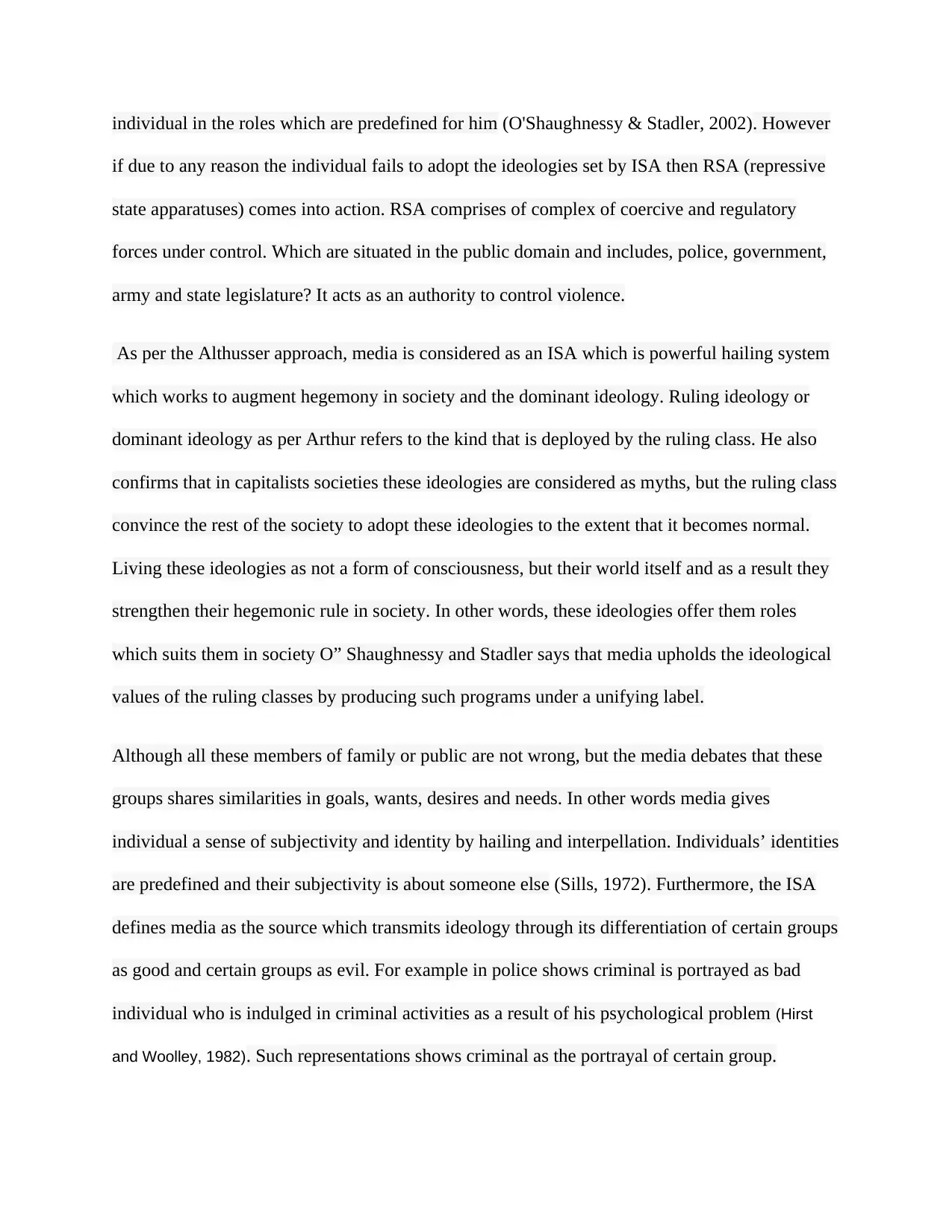
individual in the roles which are predefined for him (O'Shaughnessy & Stadler, 2002). However
if due to any reason the individual fails to adopt the ideologies set by ISA then RSA (repressive
state apparatuses) comes into action. RSA comprises of complex of coercive and regulatory
forces under control. Which are situated in the public domain and includes, police, government,
army and state legislature? It acts as an authority to control violence.
As per the Althusser approach, media is considered as an ISA which is powerful hailing system
which works to augment hegemony in society and the dominant ideology. Ruling ideology or
dominant ideology as per Arthur refers to the kind that is deployed by the ruling class. He also
confirms that in capitalists societies these ideologies are considered as myths, but the ruling class
convince the rest of the society to adopt these ideologies to the extent that it becomes normal.
Living these ideologies as not a form of consciousness, but their world itself and as a result they
strengthen their hegemonic rule in society. In other words, these ideologies offer them roles
which suits them in society O” Shaughnessy and Stadler says that media upholds the ideological
values of the ruling classes by producing such programs under a unifying label.
Although all these members of family or public are not wrong, but the media debates that these
groups shares similarities in goals, wants, desires and needs. In other words media gives
individual a sense of subjectivity and identity by hailing and interpellation. Individuals’ identities
are predefined and their subjectivity is about someone else (Sills, 1972). Furthermore, the ISA
defines media as the source which transmits ideology through its differentiation of certain groups
as good and certain groups as evil. For example in police shows criminal is portrayed as bad
individual who is indulged in criminal activities as a result of his psychological problem (Hirst
and Woolley, 1982). Such representations shows criminal as the portrayal of certain group.
if due to any reason the individual fails to adopt the ideologies set by ISA then RSA (repressive
state apparatuses) comes into action. RSA comprises of complex of coercive and regulatory
forces under control. Which are situated in the public domain and includes, police, government,
army and state legislature? It acts as an authority to control violence.
As per the Althusser approach, media is considered as an ISA which is powerful hailing system
which works to augment hegemony in society and the dominant ideology. Ruling ideology or
dominant ideology as per Arthur refers to the kind that is deployed by the ruling class. He also
confirms that in capitalists societies these ideologies are considered as myths, but the ruling class
convince the rest of the society to adopt these ideologies to the extent that it becomes normal.
Living these ideologies as not a form of consciousness, but their world itself and as a result they
strengthen their hegemonic rule in society. In other words, these ideologies offer them roles
which suits them in society O” Shaughnessy and Stadler says that media upholds the ideological
values of the ruling classes by producing such programs under a unifying label.
Although all these members of family or public are not wrong, but the media debates that these
groups shares similarities in goals, wants, desires and needs. In other words media gives
individual a sense of subjectivity and identity by hailing and interpellation. Individuals’ identities
are predefined and their subjectivity is about someone else (Sills, 1972). Furthermore, the ISA
defines media as the source which transmits ideology through its differentiation of certain groups
as good and certain groups as evil. For example in police shows criminal is portrayed as bad
individual who is indulged in criminal activities as a result of his psychological problem (Hirst
and Woolley, 1982). Such representations shows criminal as the portrayal of certain group.
⊘ This is a preview!⊘
Do you want full access?
Subscribe today to unlock all pages.

Trusted by 1+ million students worldwide
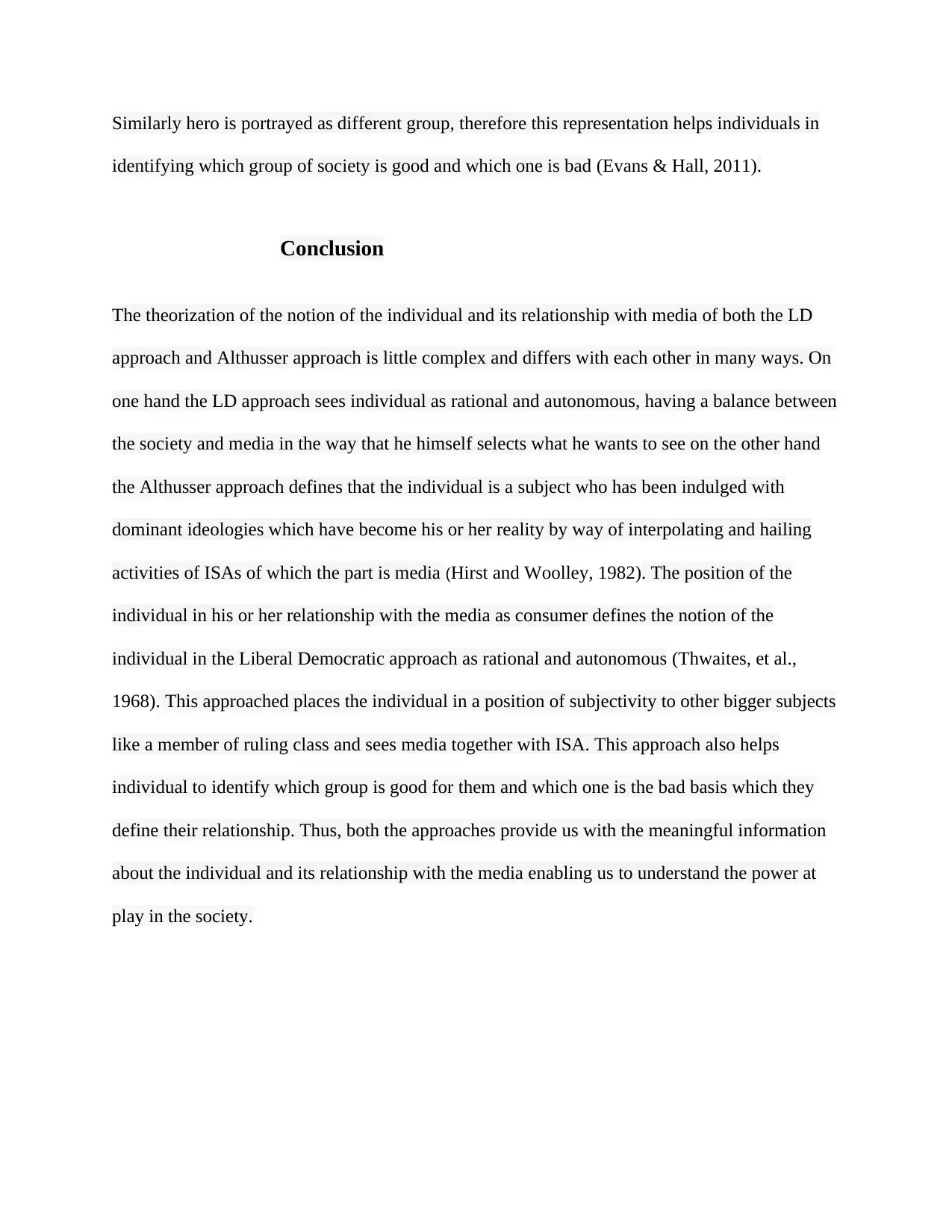
Similarly hero is portrayed as different group, therefore this representation helps individuals in
identifying which group of society is good and which one is bad (Evans & Hall, 2011).
Conclusion
The theorization of the notion of the individual and its relationship with media of both the LD
approach and Althusser approach is little complex and differs with each other in many ways. On
one hand the LD approach sees individual as rational and autonomous, having a balance between
the society and media in the way that he himself selects what he wants to see on the other hand
the Althusser approach defines that the individual is a subject who has been indulged with
dominant ideologies which have become his or her reality by way of interpolating and hailing
activities of ISAs of which the part is media (Hirst and Woolley, 1982). The position of the
individual in his or her relationship with the media as consumer defines the notion of the
individual in the Liberal Democratic approach as rational and autonomous (Thwaites, et al.,
1968). This approached places the individual in a position of subjectivity to other bigger subjects
like a member of ruling class and sees media together with ISA. This approach also helps
individual to identify which group is good for them and which one is the bad basis which they
define their relationship. Thus, both the approaches provide us with the meaningful information
about the individual and its relationship with the media enabling us to understand the power at
play in the society.
identifying which group of society is good and which one is bad (Evans & Hall, 2011).
Conclusion
The theorization of the notion of the individual and its relationship with media of both the LD
approach and Althusser approach is little complex and differs with each other in many ways. On
one hand the LD approach sees individual as rational and autonomous, having a balance between
the society and media in the way that he himself selects what he wants to see on the other hand
the Althusser approach defines that the individual is a subject who has been indulged with
dominant ideologies which have become his or her reality by way of interpolating and hailing
activities of ISAs of which the part is media (Hirst and Woolley, 1982). The position of the
individual in his or her relationship with the media as consumer defines the notion of the
individual in the Liberal Democratic approach as rational and autonomous (Thwaites, et al.,
1968). This approached places the individual in a position of subjectivity to other bigger subjects
like a member of ruling class and sees media together with ISA. This approach also helps
individual to identify which group is good for them and which one is the bad basis which they
define their relationship. Thus, both the approaches provide us with the meaningful information
about the individual and its relationship with the media enabling us to understand the power at
play in the society.
Paraphrase This Document
Need a fresh take? Get an instant paraphrase of this document with our AI Paraphraser
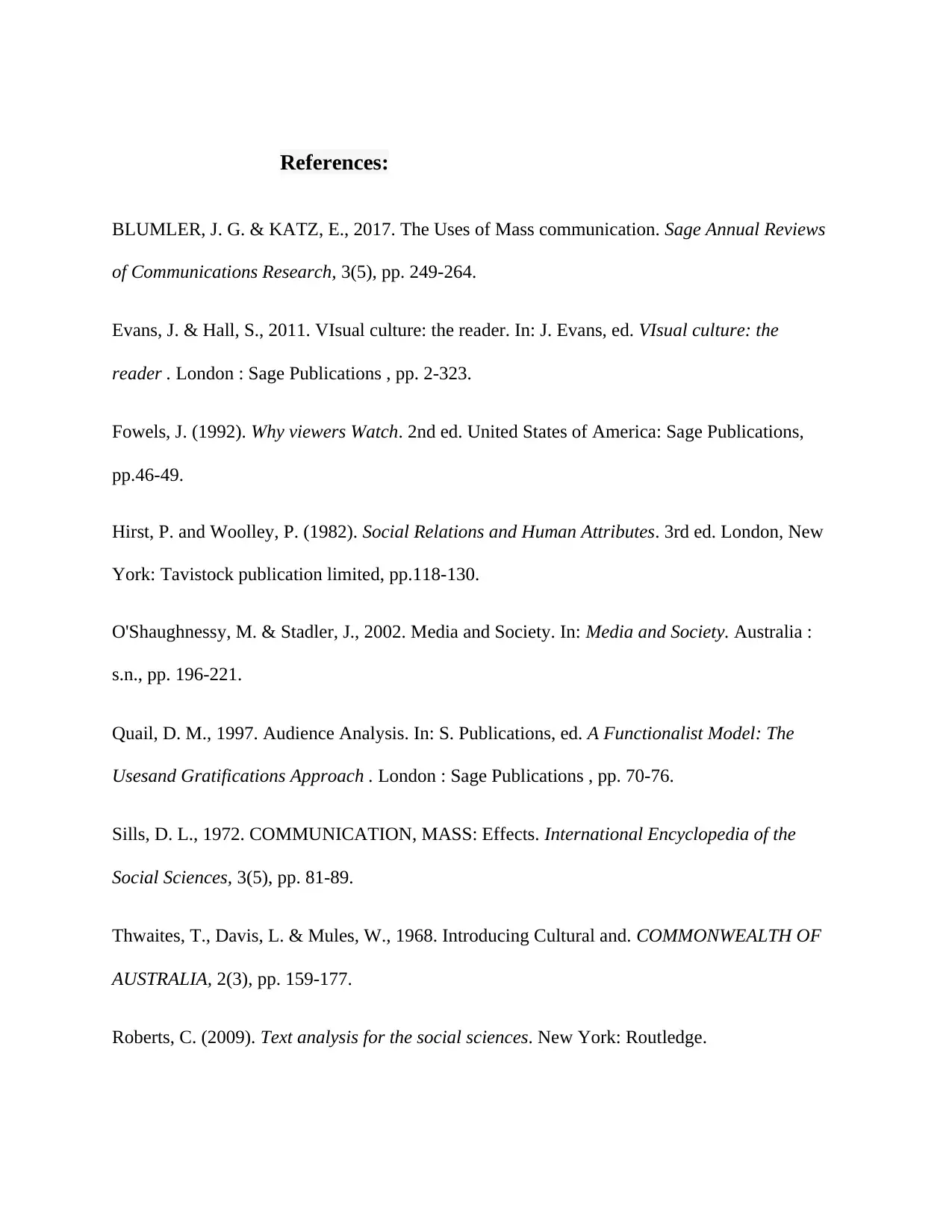
References:
BLUMLER, J. G. & KATZ, E., 2017. The Uses of Mass communication. Sage Annual Reviews
of Communications Research, 3(5), pp. 249-264.
Evans, J. & Hall, S., 2011. VIsual culture: the reader. In: J. Evans, ed. VIsual culture: the
reader . London : Sage Publications , pp. 2-323.
Fowels, J. (1992). Why viewers Watch. 2nd ed. United States of America: Sage Publications,
pp.46-49.
Hirst, P. and Woolley, P. (1982). Social Relations and Human Attributes. 3rd ed. London, New
York: Tavistock publication limited, pp.118-130.
O'Shaughnessy, M. & Stadler, J., 2002. Media and Society. In: Media and Society. Australia :
s.n., pp. 196-221.
Quail, D. M., 1997. Audience Analysis. In: S. Publications, ed. A Functionalist Model: The
Usesand Gratifications Approach . London : Sage Publications , pp. 70-76.
Sills, D. L., 1972. COMMUNICATION, MASS: Effects. International Encyclopedia of the
Social Sciences, 3(5), pp. 81-89.
Thwaites, T., Davis, L. & Mules, W., 1968. Introducing Cultural and. COMMONWEALTH OF
AUSTRALIA, 2(3), pp. 159-177.
Roberts, C. (2009). Text analysis for the social sciences. New York: Routledge.
BLUMLER, J. G. & KATZ, E., 2017. The Uses of Mass communication. Sage Annual Reviews
of Communications Research, 3(5), pp. 249-264.
Evans, J. & Hall, S., 2011. VIsual culture: the reader. In: J. Evans, ed. VIsual culture: the
reader . London : Sage Publications , pp. 2-323.
Fowels, J. (1992). Why viewers Watch. 2nd ed. United States of America: Sage Publications,
pp.46-49.
Hirst, P. and Woolley, P. (1982). Social Relations and Human Attributes. 3rd ed. London, New
York: Tavistock publication limited, pp.118-130.
O'Shaughnessy, M. & Stadler, J., 2002. Media and Society. In: Media and Society. Australia :
s.n., pp. 196-221.
Quail, D. M., 1997. Audience Analysis. In: S. Publications, ed. A Functionalist Model: The
Usesand Gratifications Approach . London : Sage Publications , pp. 70-76.
Sills, D. L., 1972. COMMUNICATION, MASS: Effects. International Encyclopedia of the
Social Sciences, 3(5), pp. 81-89.
Thwaites, T., Davis, L. & Mules, W., 1968. Introducing Cultural and. COMMONWEALTH OF
AUSTRALIA, 2(3), pp. 159-177.
Roberts, C. (2009). Text analysis for the social sciences. New York: Routledge.

⊘ This is a preview!⊘
Do you want full access?
Subscribe today to unlock all pages.

Trusted by 1+ million students worldwide
1 out of 9
Your All-in-One AI-Powered Toolkit for Academic Success.
+13062052269
info@desklib.com
Available 24*7 on WhatsApp / Email
![[object Object]](/_next/static/media/star-bottom.7253800d.svg)
Unlock your academic potential
Copyright © 2020–2025 A2Z Services. All Rights Reserved. Developed and managed by ZUCOL.

